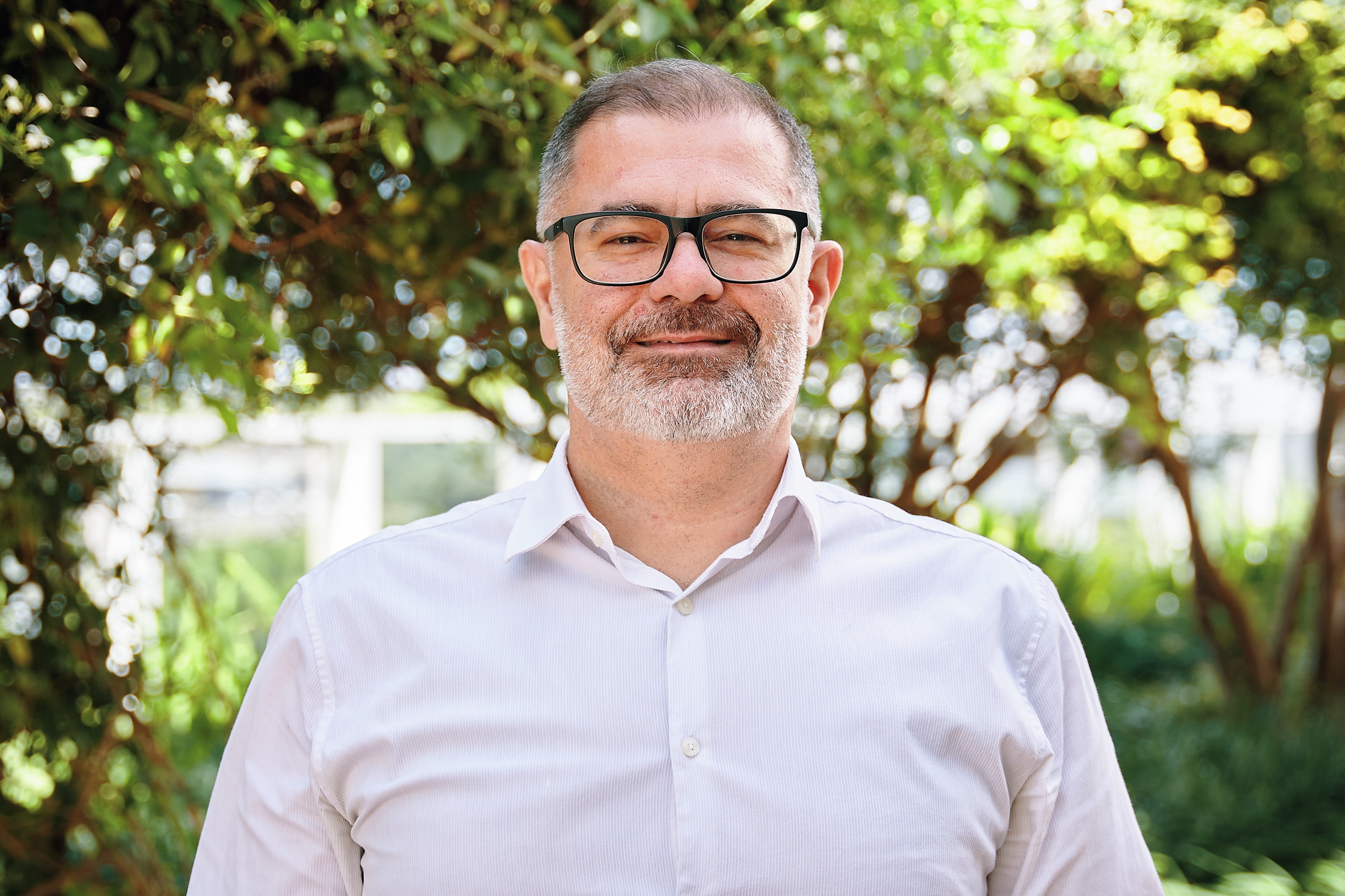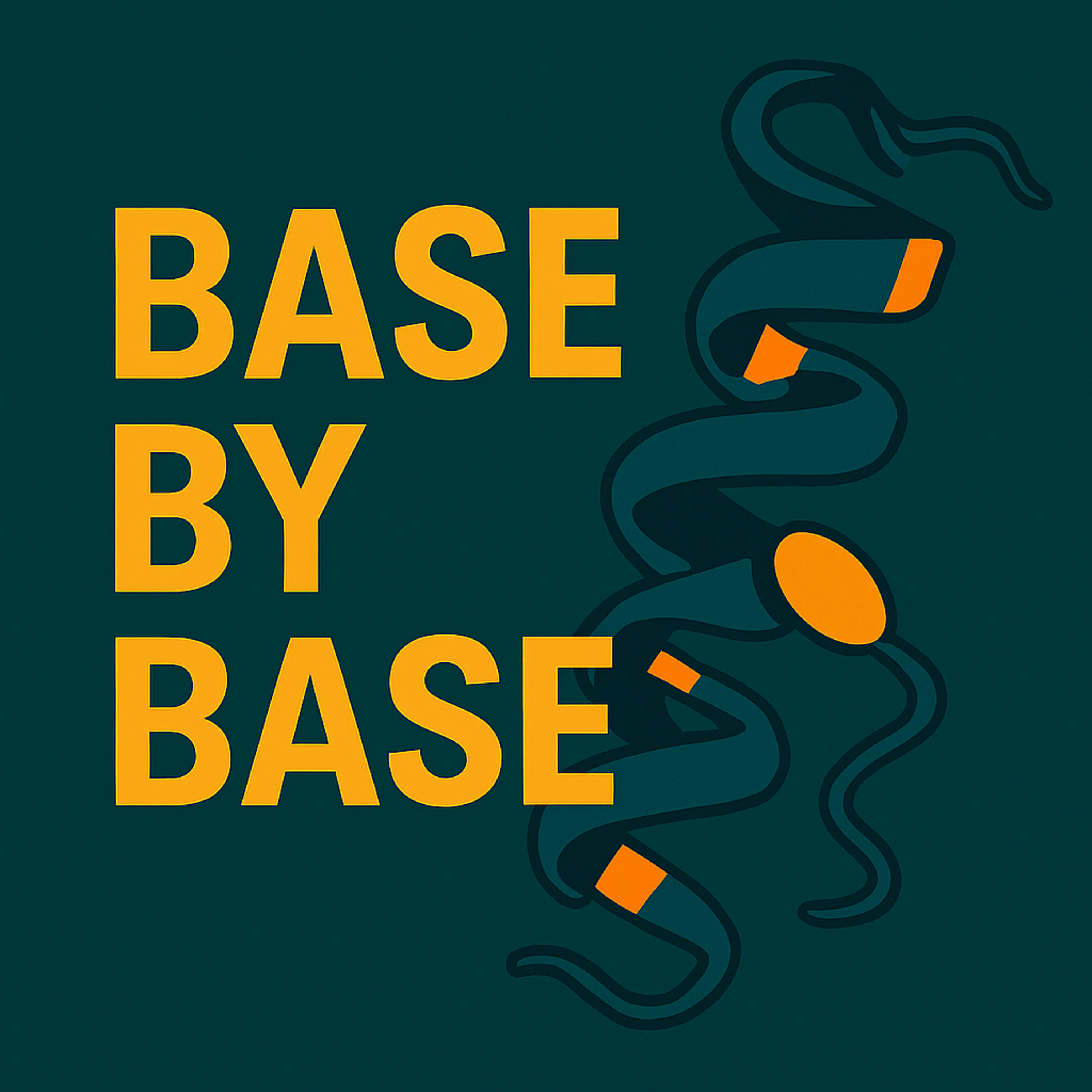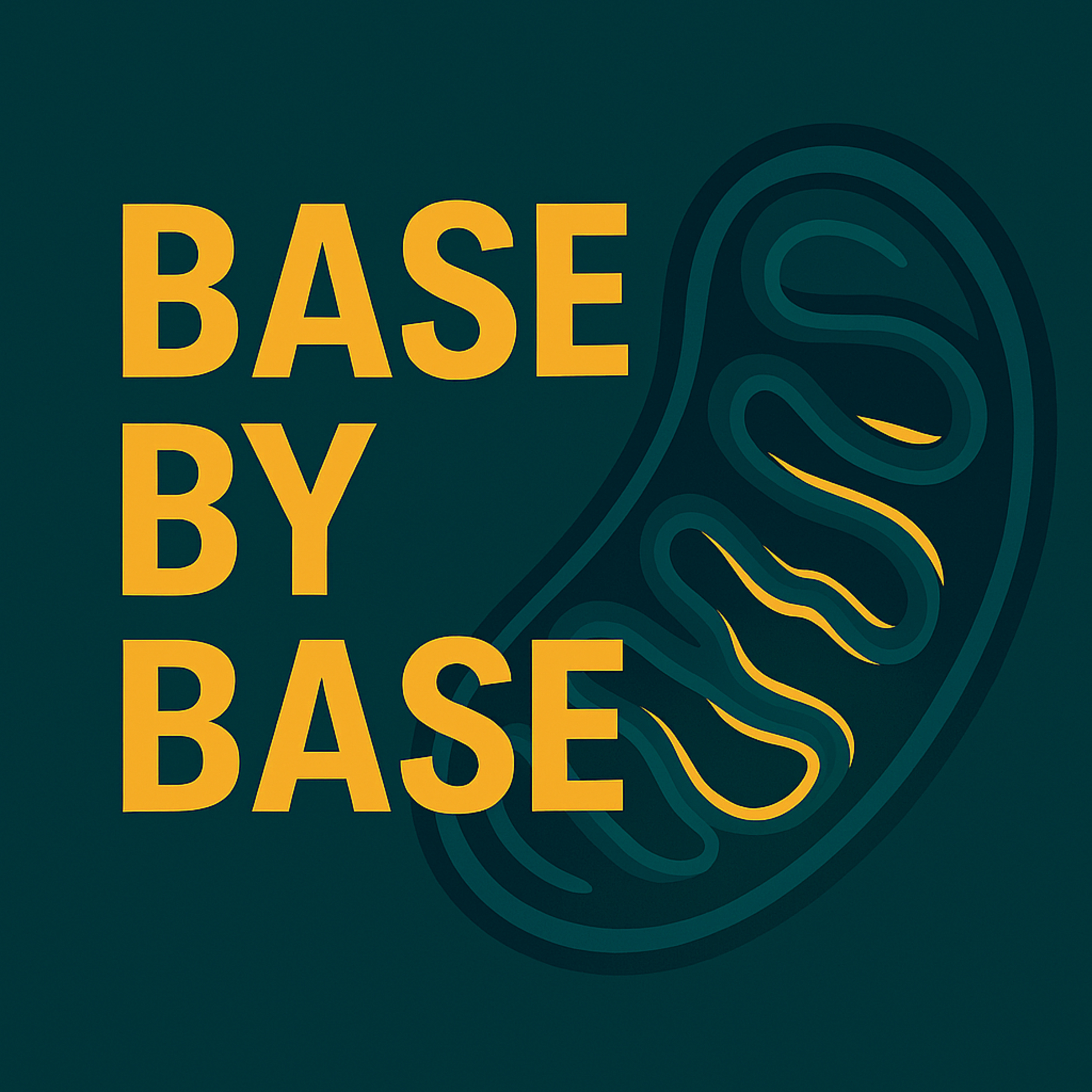Episode Transcript
[00:00:14] Speaker A: Welcome to Base by base, the paper cast that brings genomics to you wherever you are.
Okay, imagine just a single tiny letter change in your DNA. Not one that, you know, swaps out an amino acid and changes a protein's function, but a supposedly silent swap, a variant we basically assumed was completely inert. Functionally speaking, what if that tiny, seemingly harmless change could actually subtly reshape the fate of your cells? Especially those really critical immune cells, the ones fighting to keep you healthy? Yeah. I mean, for decades, these synonymous variants were like the textbook example of a genetic bystander change in the DNA letter. Sure, but the proteins stayed the same. End a story, we thought. But here's the twist. A really groundbreaking study just uncovered one of these silent mitochondrial DNA variants. And it turns out it profoundly affects our T cells, you know, those amazing warriors of our immune system. So this deep dive, it really reveals a whole new layer of genetic complexity kind of hidden away right inside your mitochondria.
[00:01:11] Speaker B: It really does. It's a finding that fundamentally challenges a core assumption in genetics. It forces us to ask, well, what really happens when one of these silent variants is. Isn't actually so silent? And how could that maybe reframe our whole understanding of cellular fitness, maybe disease susceptibility, even how our bodies adapt over time.
[00:01:28] Speaker A: So today we're celebrating the incredible work of Caleb A. Laro, Patrick Maschmeyer Lefes, Ludwig Ansimon, T. Sapathy. And while they're quite extensive team, it was a big multi institutional effort. Memorial Sloan Kettering Cancer Center, Stanford University, the Berlin Institute of Health, charity, and a lot of collaboration. And they've genuinely pushed the boundaries of how we think about mitochondrial DNA variation and its. While its unexpected impact on how our cells actually work. Okay, so let's unpack this a bit.
We know genetic variants are powerful, right? They influence everything from eye color to disease risk. But the impact of somatic variants, those are the genetic changes that pop up after you're conceived, just in some of your cells, their role outside of cancer in sort of normal, non malignant tissues that's been relatively unexplored territory. And these synonymous variants, the silent mutations, they've largely flown under the radar. We mostly ignored them because while on paper they don't change. The final prot.
Seemed logical enough.
[00:02:25] Speaker B: Exactly. And what's particularly fascinating here is the focus on mitochondrial DNA. Mtdna. You know, people call mitochondria the powerhouses of the cell, and they really are. They generate most of the cell's energy currency, ATP. But the key thing, which maybe not Everyone realizes is they have their own genomesmall. Circular, but distinct from the DNA in your nucleus. This MTDNA encodes 13 proteins that are absolutely critical for oxidative phosphorylation. That's the main energy generating process.
And crucially, each cell can have hundreds, even thousands of copies of this mtdna, which means variations within that mitochondrial genome we call a heteroplasmy are actually pretty common. You can have different MTDNA versions floating around in the same cell or the same person.
[00:03:10] Speaker A: Right, and we already knew that. Harmful MTDNA mutations, pathogenic ones, they get actively purified, selected against in certain cell types. It's like the cell's quality control, trying to keep its power plants running smoothly by weeding out faulty components. And this selection seems particularly strong in T cells. Why is that?
[00:03:26] Speaker B: Uh huh. T cells, especially when they get activated, say to fight an infection or target a tumor, their metabolic demands just skyrocket. Think of them like elite athletes suddenly sprinting. They need a huge surge of energy to multiply, to differentiate into killer cells, to do their job. And previous work had already shown that CD8 affect your memory. T cells and a key type of killer T cell are extremely sensitive to loss of function. MTDNA mutations. If their mitochondria aren't working perfectly, these immune cells just can't keep up. They falter.
So this really sets the stage perfectly for this deep dive. Could a synonymous MTGNA variant, one that isn't supposed to break the protein, still face this same kind of intense cellular selection pressure?
[00:04:06] Speaker A: Okay, so how on earth do you even start looking for something like that? A silent change with potentially subtle but important effects. This team used, well, just an incredible array of cutting edge single cell multiomics tools, getting this super detailed cell by cell picture.
[00:04:21] Speaker B: Yeah, the technology is amazing. They use techniques like mtenactac seq. What that lets you do is look at the cell's epigenetic state.
So which parts of the nuclear DNA are open and potentially active? That's the atak part. And at the same time, in the very same single cell, determine its specific mitochondrial DNA sequence, its genotype. That's the empty part.
[00:04:41] Speaker A: Wow. Okay, so you get both nuclear regulation and mitochondrial genetics from one cell.
[00:04:46] Speaker B: Exactly. It's a huge leap. And they didn't just take a snapshot. They took samples from one healthy donor over five months. That gives you a longitudinal view. You know, how these immune cells and their mitochondrial DNA might be changing or competing over time within that person.
[00:05:00] Speaker A: And they didn't stop there, did they? They layered on even more techniques.
[00:05:03] Speaker B: No they went all out. They also used single celled RNA sequencing, TRNA seq to measure which genes were being expressed, turned into RNA messages and. And T cell receptor sequencing to track different families or clones of T cells and see which ones were expanding or shrinking.
[00:05:19] Speaker A: Okay. And for the lab experiments, the in.
[00:05:21] Speaker B: Vitro stuff, right, they use things like ase psec that lets you measure cell surface proteins, which help identify the cell type and chromatin accessibility together. And the cenith assay, that's a functional one. It measures protein synthesis rates, basically telling you how metabolically active the cells are and what fuels they depend on. Glycolysis or oxidative phosphorylation.
[00:05:43] Speaker A: But the real key for figuring out the mechanism, the how, was something else, wasn't it?
[00:05:47] Speaker B: Absolutely. For understanding the why behind the effect, probably the most innovative piece was mitochondrial ribosome profiling.
This technique literally lets you map where the ribosomes, the protein making machinery, are located on the mitochondrial messenger RNAs, so you can see if they're getting stuck or slowing down at certain points, like watching for traffic jams on the assembly line.
[00:06:10] Speaker A: Okay, that's clever. And they check the nuclear DNA too?
[00:06:13] Speaker B: Yep. Whole exome sequencing of the nuclear genome, just to be thorough, to make absolutely sure there wasn't some other mutation in the nucleus that could be explaining the effects they were seeing on the mitochondria. Rule out confounders.
[00:06:25] Speaker A: An incredible toolkit. So with all that firepower, what was the first big finding, the one that really challenged the silent mutation idea?
[00:06:33] Speaker B: The core discovery was this specific variant, M7076AG. It's in the mitochondrial gene MTC01. It was mosaic, meaning the donor had a mix. About 47% of the MTDNA copies in their immune cells carried this G variant, while the rest had the normal A. And critically, it's synonymous. The normal A allele makes a GGA codon, the mutant G allele makes a GGG codon. Both GGA and GGG code for the exact same amino acid glycine at position 391 of the MTC01 protein.
[00:07:03] Speaker A: MTC01, that's part of complex 4 in the respiratory chain, Right? Crucial for energy production.
[00:07:07] Speaker B: Absolutely essential. So genetically, you look at it, same amino acid should be fine, but it wasn't fine.
[00:07:13] Speaker A: What did they actually observe happening to the cells with this G variant?
[00:07:16] Speaker B: Not fine at all. Especially in certain cells, they saw this really strong cell type specific depletion of the mutant M7076G allele. It was specifically disappearing from CD8 effector memory T cells, those high energy immune.
[00:07:29] Speaker A: Warriors we talked about, but not other T cell types?
[00:07:32] Speaker B: Not nearly to the same extent. The pattern looked remarkably similar to the kind of purifying selection we see against truly damaging pathogenic MTDNA mutations. It was like these specific T cells were actively getting rid of this supposedly silent variant.
[00:07:48] Speaker A: Okay, so if the variant is disappearing, maybe the cells just weren't making the message the MRNA properly. Did they check that?
[00:07:55] Speaker B: They did, and that's crucial. They checked the MTC01 MRNA levels and. And found no significant difference between cells with the normal A allele and cells with the mutant G allele.
[00:08:04] Speaker A: Huh. So the blueprint, the mRNA, was being made just fine.
[00:08:07] Speaker B: Exactly. That immediately pointed away from transcription or RNA stability. The problem had to be happening later, downstream, probably during translation. The actual process of making the protein from the MRNA blueprint.
[00:08:20] Speaker A: And besides just disappearing, did the variant have other functional effects on the T cells that still still carried it?
[00:08:25] Speaker B: Yes, definitely. The CD8 T cells that did have the M7076G mutation showed smaller clone sizes. They just weren't proliferating and expanding as effectively as their counterparts with the normal allele. Their gene expression was also different. Key cytotoxic genes like GNLY and KR2DL3 genes needed for killing target cells were turned down.
[00:08:47] Speaker A: So less effective killers.
[00:08:48] Speaker B: Seems like it.
And interestingly, IL7R A receptor, usually associated with less differentiated, more naive like T cells, was actually turned up. It suggests these mutant cells were struggling to fully mature into those potent effector T cells. They were at a clear competitive disadvantage.
[00:09:05] Speaker A: Okay, so we have these highly active T cells, the CD8 effector memory cells, specifically kicking out this silent variant. The MRNA levels look okay, but the cells aren't functioning as well. How can a change from GGA to ggg, both coding for glycine, cause such a fuss at the molecular level?
[00:09:20] Speaker B: Right. That's the core puzzle. And the answer seems to lie in the very unique way mitochondria handle translation, specifically with their TRNAs. You see, unlike the nucleus, which has a large redundant set of transfer RNAs to bring Amino acids to the ribosome, human mitochondria have a remarkably limited set. Only 22 TRNAs for all the codons for glycine, the amino acid here, there's only one specific mitochondrial tRNA. MTTRNA glycogen.
[00:09:49] Speaker A: Only one?
[00:09:50] Speaker B: Okay, only one. Now, this single TRNA can decode the normal GGA codon perfectly fine using standard Watson Crick base pairing. Easy peasy. But Translating the mutant GGG codon. That requires something called wobble dependent translation, where the pairing between the codon on the MRNA and the anticodon on the TRNA isn't quite perfect. At the third position, it can still happen, but it's generally less efficient, slower.
[00:10:14] Speaker A: Ah, okay. So the machinery struggles a bit with that GGG codon because the TRNA isn't a perfect match.
[00:10:19] Speaker B: That's the idea. It's like trying to fit a slightly wrong key into a lock. It might work eventually, but it takes more jiggling, slows things down.
[00:10:25] Speaker A: And the ribosome profiling the meteorobasec. That's what showed this slowdown happening?
[00:10:30] Speaker B: Exactly. That was the smoking gun. They looked at the fragments of MRNA being actively protected by ribosomes, basically the bits being translated right then. And they found a significant enrichment of the mutant M7076G allele in those ribosome protected fragments compared to the overall MRNA pool.
[00:10:48] Speaker A: Meaning ribosomes were spending more time piling up on the GGG cod.
[00:10:53] Speaker B: Precisely. It's strong evidence of translational stalling. The ribosomes were hitting that mutant codon and pausing, or at least significantly slowing down, as they tried to decode it with that single, less optimal MTTR and agli. So even though the final protein sequence is the same, the rate in which this crucial MTC01 protein could be produced was likely impaired in cells with the variant.
[00:11:15] Speaker A: And in cells with high energy demands, like activated T cells, even a small slowdown in producing a key energy component could be a major problem.
[00:11:22] Speaker B: A major problem enough to create disadvantage and lead to the purifying selection they observed.
[00:11:28] Speaker A: Wow. And this wasn't just about this one specific variant. Right. They looked at the bigger evolutionary picture, too.
[00:11:34] Speaker B: That's right. They zoomed out and looked at codon usage across the mitochondrial genome over evolutionary time. They found evidence suggesting that many common MTDNA variations that define human haplogroups, those ancient ancestral lineages, actually seem to result in more optimized codon and anticodon pairings.
[00:11:53] Speaker A: So evolution might be subtly fine tuning mitochondrial codons for better translation efficiency?
[00:11:58] Speaker B: It looks that way. Like a slow passive optimization process, favoring codon pairings that match the limited mitochondrial TRNA pool better. It suggests this translational efficiency really matters for long term fitness.
[00:12:10] Speaker A: So, let's talk implications. What does this all mean? I mean, this really shifts how we should think about silent mutations, doesn't it?
[00:12:16] Speaker B: It really does. The number one takeaway is that synonymous variants are not universally silent or neutral. They can have Real, measurable functional consequences, particularly by affecting things like codon usage and how efficiently TRNAs can recognize them.
Especially, it seems, in contexts of high metabolic demand where efficiency is paramount. It's like a hidden layer of regulation within the mitochondrial genome that we mostly just ignored.
[00:12:41] Speaker A: And it really underscores the importance of cell type specificity.
[00:12:45] Speaker B: Absolutely. A mutation that might be genuinely silent in, say, a skin cell with lower energy needs could be actively detrimental in a high demand cell, like an activated T cell, simply because of its metabolic state, or maybe even subtle differences in its TRNA availability. Context is everything.
[00:13:01] Speaker A: Which makes you wonder, how many other silent mutations have we dismissed?
[00:13:05] Speaker B: Exactly how many others, both in mitochondria and maybe even in the nucleus, might have similar hidden, context specific effects. This could really change how we think about genetic risk factors for diseases, especially complex ones. Maybe some susceptibility lies in these subtle translational effects. It could also influence our understanding of immune responses, tissue aging, maybe even subtle aspects of development.
[00:13:29] Speaker A: So where does the research go from here?
[00:13:32] Speaker B: Well, this definitely calls for larger studies. We need to look across bigger populations to see how common these kinds of functional, synonymous variants are. And now we have the tools. Advances in single cell multiomics are huge.
Plus, things like mitochondrial based editing are becoming feasible.
[00:13:46] Speaker A: Meaning we could potentially test these effects directly, maybe even correct them potentially.
[00:13:52] Speaker B: Down the line, it allows for much more precise functional testing. But broadly, it encourages us to keep digging into somatic evolution, how our cells change genetically over our lifetime using single cell approaches, and to look beyond just the obvious gain or loss of function mutations we usually associate with cancer, and appreciate these more subtle regulatory effects.
[00:14:14] Speaker A: Though it's important to remember this initial study was primarily based on one donor with this specific, fairly common variant level.
[00:14:21] Speaker B: Right. Replication and validation in larger, diverse cohorts is definitely a necessary next step. But as a proof of principle, it's incredibly compelling.
[00:14:30] Speaker A: Okay, so to wrap up the main message here, this deep dive shows us that even these seemingly silent changes in our mitochondrial DNA, they can significantly impact how well our cells function, especially those hardworking immune cells. It affect their fitness, their ability to do their job.
[00:14:45] Speaker B: Yeah, and the mechanism is fascinating. The limited TRNA supply in mitochondria means a simple codon change, even if it codes for the same amino acid, can become a translational bottleneck. It really highlights this previously underappreciated layer of genetic control that influences cell fate and survival.
[00:15:02] Speaker A: So the big question it leaves us with is what does this really mean for how we understand genetic risk? The fine tuning of our immune system and perhaps even the quiet, subtle fore forces that have shaped human evolution over millennia. It seems the silence might not be so silent after all. This episode was based on an Open Access article under the CCBY 4.0 license. You can find a direct link to the paper and the license in our episode description. If you enjoyed this, follow or subscribe in your podcast app and leave a five star rating. If you'd like to support our work, use the donation link in the description. Thanks for listening and join us next time as we explore more science base by base.




